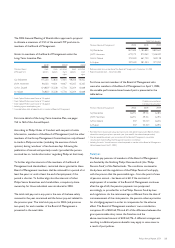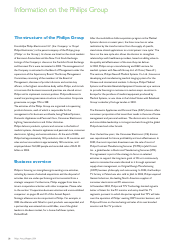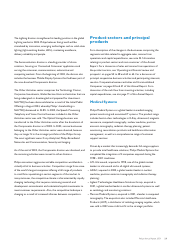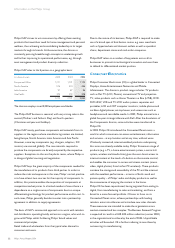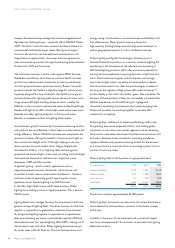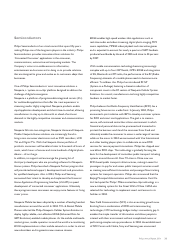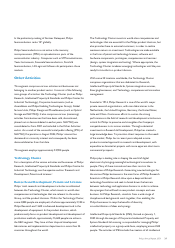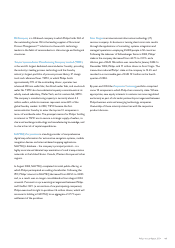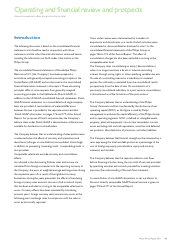Philips 2004 Annual Report Download - page 36
Download and view the complete annual report
Please find page 36 of the 2004 Philips annual report below. You can navigate through the pages in the report by either clicking on the pages listed below, or by using the keyword search tool below to find specific information within the annual report.Semiconductors
Philips Semiconductors has a track record that spans fifty years,
making Philips one of the long-term players in the industry. Philips
Semiconductors provides innovative silicon solutions for
‘Connected Consumer’ applications in the consumer,
communications, automotive and computing markets. The
Company’s vision is to enable access to information,
entertainment and services and in doing so to provide solutions
that are designed to grow and evolve as its customers adapt their
businesses.
One of Philips Semiconductors’ most innovative solutions is
Nexperia, a ‘system-on-a-chip’ platform designed to address the
challenge of digital convergence.
Nexperia is a platform of programmable integrated circuits (ICs)
for multimedia applications that offer the ‘next experience’ in
streaming media. Highly integrated, Nexperia products enable
rapid application development and short time-to-market, allowing
manufacturers to stay up to date with or ahead of end-user
demands in the highly competitive consumer and communications
markets.
Nexperia falls into two categories, Nexperia Home and Nexperia
Mobile. Nexperia Home solutions are increasingly found in
living-room consumer electronics such as DVD recorders, LCD
TVs and Digital TVs. With the Nexperia Home portfolio of
products, consumers will be able to listen to thousands of hours of
music, watch hours of movies and store hundreds of digital photo
albums – all on the go.
In addition, to support and encourage the growing list of
third-party developers who are providing software for Nexperia
Home systems, Philips launched a Nexperia Partner program that
will provide technical support, development tools and promotion
for qualified developers. Also in 2004, Philips and Samsung
announced their intent to develop and implement the Universal
Home Application Programming Interface (UH API) to speed
development of ‘connected consumer’ applications. Ultimately
these programs mean consumers can enjoy more features at ‘living
room’ prices.
Nexperia Mobile has been adopted by a number of leading handset
manufacturers around the world. In 2004, TCL & Alcatel Mobile
Phones selected the Philips Nexperia Cellular System Solution to
deploy highly reliable, cost-effective EDGE (Enhanced Data for
GSM Evolution)-enabled mobile phones. As the mobile multimedia
market grows, mobile operators around the world are considering
EDGE implementation in their mobile networks in order to attract
new subscribers and to generate new revenue streams.
EDGE enables high-speed wireless data applications such as
real-time audio and video streaming, digital photo imaging, MP3
music capabilities, MPEG4 video playback and interactive games
and is expected to account for nearly a quarter of GSM handsets
produced worldwide by the end of 2005 and close to 50 percent
by 2007.
With mobile communication technology becoming increasingly
complex with up to four GSM bands, GPRS, EDGE and integration
of 3G, Bluetooth and FM radio, the performance of the RF (Radio
Frequency) elements of a mobile phone needs to become more
efficient. To address this, Philips has introduced RF SiP
(System-in-a-Package) featuring a dramatic reduction of
component count in the RF section of Nexperia Cellular System
Solutions. As a result, manufacturers can bring highly competitive
handsets to market faster.
Philips believes that Radio Frequency Identification (RFID) has a
promising future across a wide front. In January 2004, Philips
announced a joint initiative with IBM to develop customer systems
for RFID and smart card applications. The goal is to create a
secure, self-contained contactless silicon environment in which
financial and personal data can be processed and transacted to
protect the business world and the consumer from fraud and
ultimately enable the consumer to access a wide range of services
while on the move. In 2004 we announced with Visa International
and other leading players plans to collaborate on new RFID
services for secure payment transactions. Philips has shipped over
one billion RFID chips. This technology is gradually forming the
basis for the development of contactless public transport ticketing
systems around the world. Over 70 cities in China now use
RFID-based public transport infrastructures, making it easier for
passengers to pay for and access public transport services as well
as creating more efficient transaction and passenger flow tracking
systems for transport operators. Philips also announced that the
Beijing Municipal Administration and Communications Card Co.
Ltd. had opted for Philips’ Mifare contactless chip technology in a
new e-ticketing system for the Great Wall of China. NASA also
selected this technology to implement smart card access to its
facilities in 2004.
Near Field Communication (NFC) is also an exciting growth area.
Evolving from a combination of RFID and interconnecting
technologies, NFC technology bridges today’s connectivity gap. It
enables the simple transfer of information and allows people to
interact with their environment without complicated menus or
performing complex set-up procedures. In 2004, the establishment
of NFC Forum with Nokia, Sony and Samsung was announced.
35Philips Annual Report 2004


